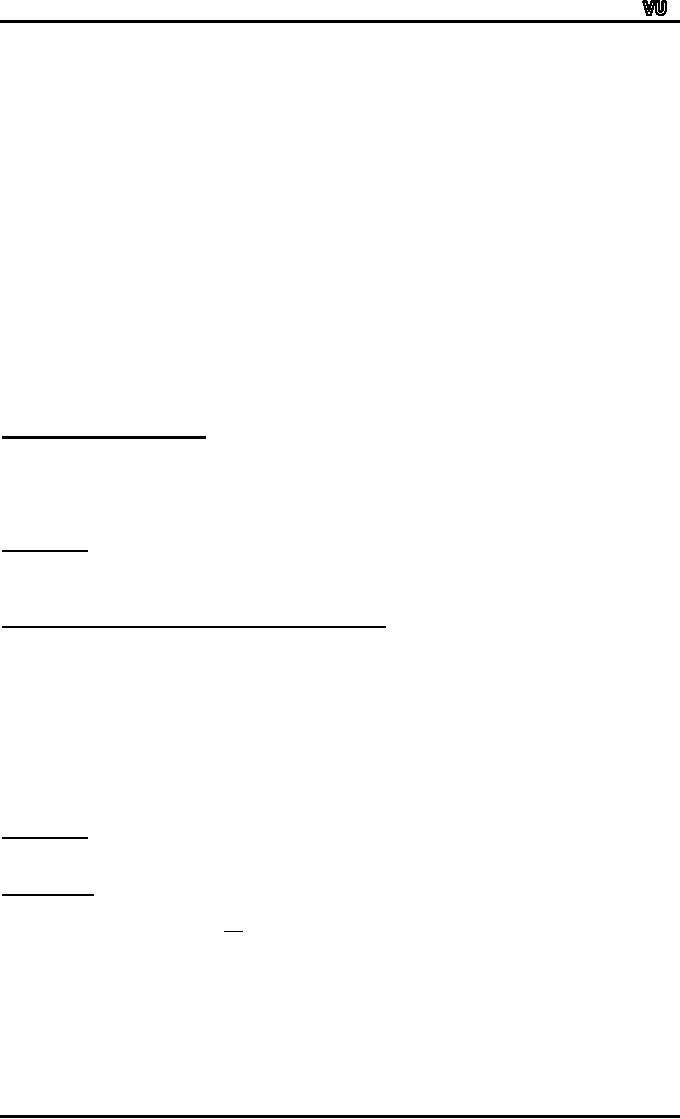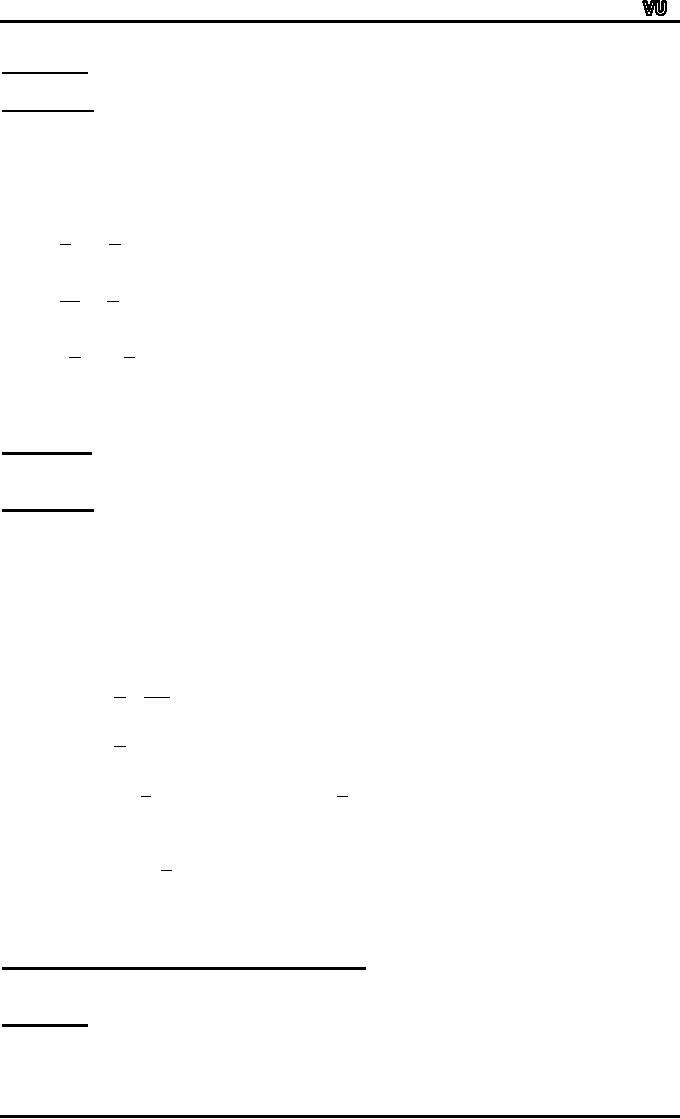 |
SEQUENCE:ARITHMETIC SEQUENCE, GEOMETRIC SEQUENCE: |
| << INJECTIVE FUNCTION or ONE-TO-ONE FUNCTION:FUNCTION NOT ONTO |
| SERIES:SUMMATION NOTATION, COMPUTING SUMMATIONS: >> |

MTH001
Elementary Mathematics
LECTURE #
13
SEQUENCE:
A
sequence is just a list of
elements usually written in a
row.
EXAMPLES:
1.
1,
2, 3, 4, 5, ...
2.
4,
8, 12, 16, 20,...
3.
2,
4, 8, 16, 32, ...
4.
1,
1/2, 1/3, 1/4, 1/5,
...
5.
1,
4, 9, 16, 25, ...
6.
1,
-1, 1, -1, 1, -1, ...
NOTE:
The
symbol "..." is called ellipsis,
and reads "and so
forth"
FORMAL
DEFINITION:
A
sequence is a function whose
domain is the set of
integers greater than or
equal to a
particular
integer n0.
Usually
this set is the set of
Natural numbers {1, 2, 3, ...} or
the set of whole numbers
{0, 1,
2,
3, ...}.
NOTATION:
We
use the notation an to
denote the image of the
integer n, and call it a
term of the
sequence.
Thus
a1,
a2, a3, a4 ...,
an, ...
represent
the terms of a sequence
defined on the set of
natural numbers N.
Note
that a sequence is described by
listing the terms of the
sequence in order of
increasing
subscripts.
FINDING
TERMS OF A SEQUENCE GIVEN BY AN
EXPLICIT FORMULA:
An
explicit formula or general
formula for a sequence is a
rule that shows how
the values of
ak depends on k.
EXAMPLE:
Define
a sequence a1,
a2, a3, ... by the
explicit formula
k
ak =
for
all integers k
≥
1
k
+1
The
first four terms of the
sequence are:
1
1
2
2
3
3
a1 =
=
,
a2 =
=
,
a3 =
=
1+1
2
2
+1
3
3
+1
4
4
4
and
fourth term is a4 =
=
4
+1
5
EXAMPLE:
Write
the first four terms of
the sequence defined by the
formula
bj
= 1 + 2j,
for all integers j ≥ 0
SOLUTION:
b0 = 1 +
20 = 1 + 1 = 2
b1 = 1 +
21 = 1 + 2 = 3
b2 = 1 +
22 = 1 + 4 = 5
b3 = 1 +
23 = 1 + 8 = 9
REMARK:
The
formula bj = 1 + 2 j , for all integers j
≥ 0 defines an
infinite sequence having
infinite
number
of values.
Page
79

MTH001
Elementary Mathematics
EXERCISE:
Compute
the first six terms of
the sequence defined by the
formula
Cn
=
1+ (-1) n for
all integers n ≥
0
SOLUTION
:
C0 = 1 +
(-1) 0= 1 + 1
= 2
C1 = 1 +
(-1)1
= 1 + (-1) =
0
C2 = 1 +
(-1)2
= 1 + 1 =
2
C3 = 1 +
(-1)3
= 1 + (-1) =
0
C4 = 1 +
(-1)4
= 1 + 1 =
2
C5 = 1 +
(-1)5
= 1 + (-1) =
0
REMARK:
(1)If
n is even, then Cn =
2 and if n is odd, then Cn =
0
Hence,
the sequence oscillates
endlessly between 2 and
0.
(2)An
infinite sequence may have
only a finite number of
values.
EXAMPLE:
Write
the first four terms of
the sequence defined
by
(-1)n
n
Cn =
for
all integers n
≥
1
n
+1
SOLUTION:
(-1)1 (1) -1
(-1)2 (2) 2
(-1)3 (3) -3
C1 =
=
,
C2 =
=
,
C3 =
=
1+1
2
+1
3
+1
2
3
4
(-1)4 (4) 4
And
fourth term isC4 =
=
4
+1
5
REMARK:A
sequence whose terms
alternate in sign is called an
alternating sequence.
EXERCISE:
Find
explicit formulas for
sequences with the initial
terms given:
1.
0,
1, -2, 3, -4, 5, ...
SOLUTION:
an =
(-1) n+1n
for all integers n ≥ 0
11
11 11 1
2.
1
-
,
-
,
-
,
-
,L
22
33 44 5
SOLUTION:
1
1
bk =
-
for
all integers n
≥
1
k
k +1
3.
2,
6, 12, 20, 30, 42,
56, ...
SOLUTION:
Cn = n (n + 1)
for all integers n ≥ 1
4.
1/4,
2/9, 3/16, 4/25, 5/36,
6/49, ...
SOLUTION:
i
di =
for
all integers i
≥
1
(i +
1)2
OR
j
+1
dj =
for
all integers j
≥
0
(
j
+
2)2
ARITHMETIC
SEQUENCE:
Page
80

MTH001
Elementary Mathematics
A
sequence in which every term
after the first is obtained
from the preceding term by
adding
a
constant number is called an
arithmetic sequence or arithmetic
progression (A.P.)
The
constant number, being the
difference of any two
consecutive terms is called
the
common
difference of A.P., commonly
denoted by "d".
EXAMPLES:
1.
5,
9, 13, 17, ...
(common
difference = 4)
2.
0,
-5, -10, -15, ...
(common
difference = -5)
3.
x
+ a, x + 3a, x + 5a, ...
(common
difference = 2a)
GENERAL
TERM OF AN ARITHMETIC
SEQUENCE:
Let
a
be the
first term and d be the
common difference of an arithmetic
sequence. Then the
sequence
is a, a+d, a+2d, a+3d,
...
If
ai,
for i ≥
1,
represents the terms of the
sequence then
a1 =
first term = a = a + (1-1)
d
a2 =
second term = a + d = a + (2-1)
d
a3 =
third term = a + 2d = a + (3 -1)
d
By
symmetry
an =
nth term = a + (n - 1)d for
all integers n ≥1.
EXAMPLE:
Find
the 20th term of the
arithmetic sequence
3,
9, 15, 21, ...
SOLUTION:
Here
a = first term = 3
d
= common difference = 9 - 3 = 6
n
= term number = 20
a20 =
value of 20th term =
?
n
≥1
Since
an =
a + (n - 1) d;
∴
a20 = 3 +
(20 - 1) 6
=
3 + 114
=
117
EXAMPLE:
Which
term of the arithmetic
sequence
4,
1, -2, ...,
is
-77
SOLUTION:
Here
a = first term = 4
d
= common difference = 1 - 4 = -3
an =
value of nth term = -
77
n
= term number = ?
Since
n
≥1
an
= a + (n - 1) d
⇒
-
77 = 4 + (n - 1) (-3)
⇒
-
77 - 4 = (n - 1) (-3)
OR
-81
=
n
-1
-3
OR
27
= n 1
n
= 28
Hence
77 is the 28th term of
the given sequence.
EXERCISE:
Find
the 36th term of the
arithmetic sequence whose
3rd term is 7 and 8th
term is 17.
SOLUTION:
Let
a
be the
first term and d be the
common difference of the
arithmetic sequence.
Page
81

MTH001
Elementary Mathematics
Then
n≥1
an = a + (n -
1)d
⇒
a3 = a + (3 - 1)
d
and
a8 = a + (8 - 1)
d
Given
that a3 =
7 and a8
= 17.
Therefore
7
= a + 2d........................(1)
and
17 = a + 7d........................(2)
Subtracting
(1) from (2), we
get,
10
= 5d
⇒
d=2
Substituting
d = 2 in (1) we have
7
= a + 2(2)
which
gives a = 3
Thus,
an =
a + (n - 1) d
an = 3 + (n - 1)
2
(using
values of a and d)
Hence
the value of 36th term
is
a36 = 3 +
(36 - 1) 2
=
3 + 70
=
73
GEOMETRIC
SEQUENCE:
A
sequence in which every term
after the first is obtained
from the preceding term
by
multiplying
it with a constant number is
called a geometric sequence or
geometric
progression
(G.P.)
The
constant number, being the
ratio of any two consecutive
terms is called the
common
ratio
of the G.P. commonly denoted
by "r".
EXAMPLE:
1.
1,
2, 4, 8, 16, ...
(common
ratio = 2)
2.
3,
- 3/2, 3/4, - 3/8,
...
(common
ratio = - 1/2)
3.
0.1, 0.01,
0.001,
0.0001, ...
(common ratio = 0.1 =
1/10)
GENERAL
TERM OF A GEOMETRIC
SEQUENCE:
Let
a
be the
first tem and r be the
common ratio of a geometric
sequence. Then the
sequence
is a, ar, ar2,
ar3, ...
If
ai,
for i ≥
1
represent the terms of the
sequence, then
a1 =
first term = a = ar1-1
a2 =
second term = ar = ar2-1
a3 =
third term = ar2 =
ar3-1
..................
..................
an =
nth term = arn-1; for all
integers n ≥
1
EXAMPLE:
Find
the 8th term of the
following geometric
sequence
4,
12, 36, 108, ...
SOLUTION:
Here
a = first term = 4
12
=
3
r
= common ratio =
n
= term number = 8 4
a8 =
value of 8th term = ?
Since
an = arn-1;
n≥1
8-1
⇒
a8 =
(4)(3)
=
4 (2187)
=
8748
Page
82

MTH001
Elementary Mathematics
EXAMPLE:
Which
term of the geometric
sequence is 1/8 if the first
term is 4 and common ratio
Ĺ
SOLUTION:
Given
a = first term = 4
r
= common ratio = 1/2
an =
value of the nth term =
1/8
n
= term number = ?
Since
an =
arn-1
n≥1
n-1
⎛1⎞
1
⇒
=
4⎜
⎟
8
⎝
2⎠
n-1
1
⎛1⎞
⇒
=⎜
⎟
32
⎝
2
⎠
n-1
5
⎛1⎞
⎛1⎞
⇒
⎜
⎟ =⎜ ⎟
⎝
2⎠
⎝ 2⎠
⇒
n
-1 =
5
⇒n=6
Hence
1/8 is the 6th term of
the given G.P.
EXERCISE:
Write
the geometric sequence with
positive terms whose second
term is 9 and fourth term
is
1.
SOLUTION:
Let
a
be the
first term and r be the
common ratio of the
geometric sequence.
Then
an = ar
n-1
n
≥1
2-1
Now
a2 =
ar
⇒
9
= ar......................(1)
a4 =
ar4-1
Also
1
= ar 3
.....................(2)
Dividing
(2) by (1), we get,
1
ar
3
=
9
ar
1
⇒
=
r2
9
⎛
1⎞
1
⇒
r=
rejecting
r
=
- ⎟
⎜
3
3⎠
⎝
Substituting
r = 1/3 in (1), we
get
⎛1⎞
9
=
a⎜
⎟
⎝
3⎠
⇒
a
=
9
◊
3
=
27
Hence
the geometric sequence
is
27,
9, 3, 1, 1/3, 1/9, ...
SEQUENCES
IN COMPUTER PROGRAMMING:
An
important data type in
computer programming consists of
finite sequences known
as
one-dimensional
arrays; a single variable in
which a sequence of variables
may be stored.
EXAMPLE:
The
names of k students in a class
may be represented by an array of k
elements "name"
as:
name
[0],
name[1],
name[2],
..., name[k-1]
Page
83
Table of Contents:
- Recommended Books:Set of Integers, SYMBOLIC REPRESENTATION
- Truth Tables for:DE MORGANíS LAWS, TAUTOLOGY
- APPLYING LAWS OF LOGIC:TRANSLATING ENGLISH SENTENCES TO SYMBOLS
- BICONDITIONAL:LOGICAL EQUIVALENCE INVOLVING BICONDITIONAL
- BICONDITIONAL:ARGUMENT, VALID AND INVALID ARGUMENT
- BICONDITIONAL:TABULAR FORM, SUBSET, EQUAL SETS
- BICONDITIONAL:UNION, VENN DIAGRAM FOR UNION
- ORDERED PAIR:BINARY RELATION, BINARY RELATION
- REFLEXIVE RELATION:SYMMETRIC RELATION, TRANSITIVE RELATION
- REFLEXIVE RELATION:IRREFLEXIVE RELATION, ANTISYMMETRIC RELATION
- RELATIONS AND FUNCTIONS:FUNCTIONS AND NONFUNCTIONS
- INJECTIVE FUNCTION or ONE-TO-ONE FUNCTION:FUNCTION NOT ONTO
- SEQUENCE:ARITHMETIC SEQUENCE, GEOMETRIC SEQUENCE:
- SERIES:SUMMATION NOTATION, COMPUTING SUMMATIONS:
- Applications of Basic Mathematics Part 1:BASIC ARITHMETIC OPERATIONS
- Applications of Basic Mathematics Part 4:PERCENTAGE CHANGE
- Applications of Basic Mathematics Part 5:DECREASE IN RATE
- Applications of Basic Mathematics:NOTATIONS, ACCUMULATED VALUE
- Matrix and its dimension Types of matrix:TYPICAL APPLICATIONS
- MATRICES:Matrix Representation, ADDITION AND SUBTRACTION OF MATRICES
- RATIO AND PROPORTION MERCHANDISING:Punch recipe, PROPORTION
- WHAT IS STATISTICS?:CHARACTERISTICS OF THE SCIENCE OF STATISTICS
- WHAT IS STATISTICS?:COMPONENT BAR CHAR, MULTIPLE BAR CHART
- WHAT IS STATISTICS?:DESIRABLE PROPERTIES OF THE MODE, THE ARITHMETIC MEAN
- Median in Case of a Frequency Distribution of a Continuous Variable
- GEOMETRIC MEAN:HARMONIC MEAN, MID-QUARTILE RANGE
- GEOMETRIC MEAN:Number of Pupils, QUARTILE DEVIATION:
- GEOMETRIC MEAN:MEAN DEVIATION FOR GROUPED DATA
- COUNTING RULES:RULE OF PERMUTATION, RULE OF COMBINATION
- Definitions of Probability:MUTUALLY EXCLUSIVE EVENTS, Venn Diagram
- THE RELATIVE FREQUENCY DEFINITION OF PROBABILITY:ADDITION LAW
- THE RELATIVE FREQUENCY DEFINITION OF PROBABILITY:INDEPENDENT EVENTS